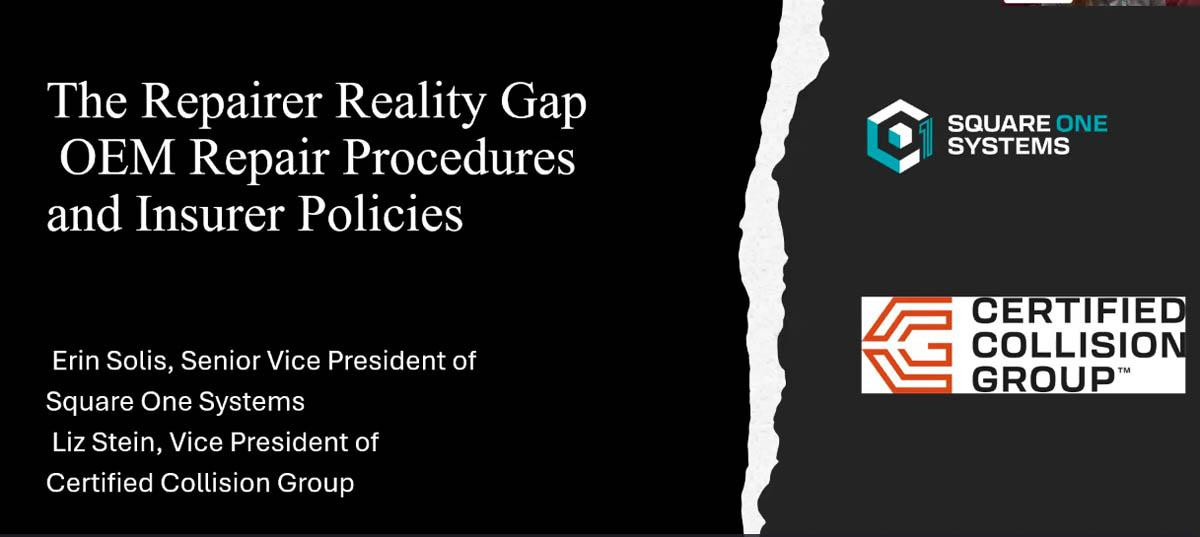A free webinar exploring the underlying causes of the disconnect between OEM repair procedures and insurer payment policies — including differing priorities, compliance costs, regulatory gaps and a widespread knowledge deficit — and providing actionable strategies to bridge it is now available on-demand to anyone who fills out a simple form.
Aired live June 4 by Autobody News, the webinar featured Liz Stein, vice president of Certified Collision Group (CCG), and Erin Solis, senior vice president of Square One Systems.
The webinar opened with a review of the factors that have led to the chasm.
“How did we get here?” asked Stein.
Vehicle technology — including ADAS features, metals and powertrains — has advanced so much in the last 10 years compared to the entire 30 years before that, Solis acknowledged.
“It’s a lot for everyone to stay on top of updates,” she said.
There can be a vast difference between OEMs, or even different trim levels of the same model.
“We have been talking about this as an industry since at least 2015,” Stein said.
Top Industry Trends as of 2024
The U.S. car parc is aging as people hold on to their vehicles longer. In 2024, 45% of all repairable vehicles were 7 years old or older, up from 35% in 2019.
Third party bodily injury claims were up 8%, and auto casualty claims involving uninsured or underinsured motorists were up 11%.
The average severity increased from $2,169 in 2014 to $5,470 in 2023.
Addressing the Repairer Reality Gap
Stein and Solis discussed the customer experience expectations that have been set by other companies like Amazon, Uber and DoorDash.
“It’s instant gratification,” Solis said. “That’s the consumer we’re dealing with today.”
Health care is another industry dealing with similar challenges as collision repair, trying to balance insurers’ policies with consumers’ demands and expectations.
Stein and Solis discussed how to educate customers so they feel like they know all of their options and have a choice in the repair process.
“I see that in a lot of online reviews, that frustration that they didn’t know about every option,” Stein said.
Explaining every step of the repair process and the options for completing them also illustrates for a customer why another shop’s estimate may be lower or higher, Solis said, and builds their trust in the shop that takes the time to do so.
Stein also talked about how to offer financing options for customers who may want to pay out of pocket for procedures their insurance doesn’t cover.
“It goes back to the consumer feeling that power of choice, like they’re in the driver’s seat,” Stein added.
Building Adjuster Relations
Solis shared the story of how, when she was an adjuster who had just moved from Denver, CO, to San Diego, CA, a shop owner explained why the premium brands he repaired required different repair processes than the mass market brands and pickup trucks she had been used to assessing.
“The time he took to really show me what he was talking about built a good relationship,” she said. “That goes for your consumer, estimator, technician, receptionist — take that time and you’re going to build the trust.”
She and Stein discussed training options for learning to negotiate with adjusters.
Building Manufacturer Relations
OEM repair procedures are constantly being updated, often after receiving questions or feedback from shops.
“If shops don’t call in with questions, they don’t know there’s a problem,” Solis said.
The webinar covered how to build relationships with local dealerships as well, which can be beneficial to both sides — the dealership can refer collision repair customers to the shop, while the shop can refer total loss customers to the dealership and help facilitate a smooth sale.
Do What You Say You Are Going to Do Every Time
Solis and Stein discussed how to make sure everyone in the shop is on the same page on a repair plan, ensuring it goes exactly how the customer is told it will.
“You can’t spend all that time telling the customer what you’re going to do and then fail out of the QC process at the end,” Solis said.
That requires solid communication with staff and checks during the repair process.
In addition, everyone who touches a vehicle needs to be trained to do so. Stein and Solis discussed OEM training options.
“There’s no villains in this story, just communication and education,” Stein said.
Watch the full webinar now by clicking here.














Abby Andrews